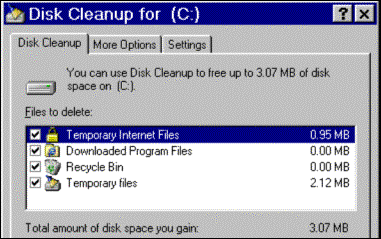Taking out the Trash
Written on April 21, 2003 by Robert & Karen Vanderzweerde
Appeared in Greenmaster Magazine
Is your computer getting slower and more sluggish? Are you running out of
disk space? Is it more difficult to find things because of clutter on your
computer?
A computer system clogged with unnecessary files and programs runs more
slowly -- a computer system needs about 10 to 15% of free disk space to run
efficiently. Even newer computers with large disk drives are affected, as the
storage space becomes more fragmented as files are created, moved, and deleted.
By keeping your computer clean, you can also speed it up.
Recycle Bin
When you delete a file on your computer, it's not really deleted at all. The
file is left on your computer but it is moved to the Recycle Bin.
This is a nice feature added to Windows to help you recover deleted files. If
you've accidentally deleted a file and want it back, simply go to the Recycle
Bin, highlight the file (i.e. mouse click once on the file), and select File |
Restore from the top menu.
However, Windows allocates up to 10% of your disk space to save
"deleted" files for an indefinite period of time. 10% may make sense
for smaller disk drives, but not for the large capacity drives being shipped
with new computers. To set aside less space, right-click on the Recycle Bin
icon, select Properties, move the arrow to a new percentage (as low as 1%), and
click OK.
You must manually empty your Recycle Bin to physically delete the files
stored there. You may do so by opening the Recycle Bin and selecting File |
Empty Recycle Bin from the top menu. Alternatively, use the Disk Cleanup utility
described next.
Disk Cleanup
The Disk Cleanup utility empties the Recycle Bin as well as getting rid of
Temporary Files that your programs create, including cached files from your
Internet browser (whenever you visit a web site, all the web pages and graphics
are stored or cached on your computer so that when you visit the web site later,
the information is quickly displayed from the cache rather than retrieving it
again from the web site).
To run, open the Start menu and select Programs | Accessories | System Tools
| Disk Cleanup (yes, it's well hidden!). Check off the files you want to delete
and click OK (see illustration for an example).

E-Mail
Microsoft Outlook and Outlook Express are notorious for not actually deleting
your e-mail when you think you've deleted it or moved it to another e-mail
folder.
When you delete e-mail, it gets moved to a Deleted Items folder (again, for
easy recovery of inadvertently deleted messages). You may remove these messages
manually (select them in the Deleted Items folders and delete them again) or you
can have the system automatically delete them for you when you close your e-mail
application - in Outlook select Tools | Options | Other and check the box beside
"Empty the Deleted Items folder upon exiting".
Even so, Outlook Express does not actually free up any disk space when you
delete messages or empty the Deleted Items folder. It simply flags the message
as deleted and you never see it again. To re-claim the disk space, you must
select File | Folder | Compact All Folders within Outlook Express. Afterwards,
you may notice that Outlook Express runs a lot faster.
Disk Defragmenter
As files are created, moved, and deleted, the disk drive becomes fragmented
as information is placed all over the disk drive. This eventually slows the
computer down as it takes longer and longer to retrieve data.
By running Disk Defragmenter, the information on your disk is reorganized to
make it more efficient. To run, open the Start menu and select Programs |
Accessories | System Tools | Disk Defragmenter (again, it's well hidden!).
Select the disk you want to optimize and click OK.
HINT #1: Make sure to clean up the rest of your disk before running the
defragmenter (i.e. run Disk Cleanup, clean out your E-Mail). Otherwise, you end
up optimizing the clutter!
WARNING: The Disk Defragmenter may take several hours to run, especially if
you've never run this before on your disk drive. You should never stop this
program once it's started.
HINT #2: Backup your data before running Disk Defragmenter. It the utility
stops in the middle of its processing, there is a possibility that your data may
be corrupted.
Remember that keeping your system neat and clean not only lets you work
faster; your computer will work faster too. So take out the trash!
|







